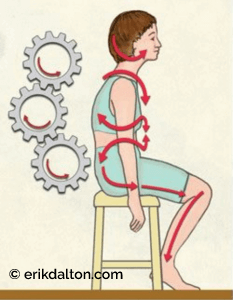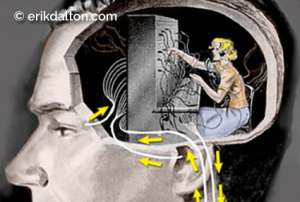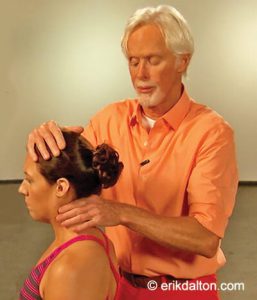
It is helpful for massage and bodyworkers to view muscle weakness from a neurological perspective. We’ve been taught that the voluntary skeletal muscle system is the largest single organ in the body measuring more than 40 percent of body weight. It is maintained in a sophisticated state of balance and coordination throughout a wide range of postures and activities. The muscles are not only the source, but also the recipient of the greatest neural activity in the body. This includes sensory and motor activity.
“Sherrington’s Law of Reciprocal Innervation” showed that muscle inhibition is frequently found in injured, inflamed and painful tissues and that the resulting inhibition or weakness leads to reciprocal facilitation of its antagonist. But, it is also true that muscle hypertonicity due to stress or strain may reciprocally inhibit its antagonist. This is the reciprocity of Sherrington’s Law and the reason it is called Law of Reciprocal Innervation and not Law of Reciprocal Inhibition as many of us learned in school. So, what does this mean to you?
The simple act of releasing tight agonist muscles as demonstrated in the video clip above, may result in increased strength in the inhibited antagonist, likely mediated via Sherrington’s 1907 Law of Reciprocal Innervation.
Manual therapists often unknowingly correct aberrant postural patterns and relieve pain by applying Sherrington’s “innervation” principle. For example, techniques that open up constricted chest wall soft tissues also reciprocally strengthen the lower shoulder stabilizers. Likewise, lengthening hypertonic lats and subscapularis muscles reciprocally strengthen the posterior rotator cuff.

Janda felt that manual therapy was not sufficient by itself to successfully treat the neuromuscular system and encouraged the use of sensorimotor training as an integral part of client care. Sensorimotor training promotes whole-body neuromuscular balance by stimulating certain areas of the brain. These include gently increasing proprioception from the bottom of the feet, deep cervical musculature, SI joints, vestibular balance training, and other specific techniques. These activities help stimulate the motor system which, in turn, improve postural control and optimize gait.
Too often, therapists defy this basic neurological concept by “fascia-mashing” stretch-weakened rhomboids and lower traps. The end result is increased pectoral tightness and greater postural deformity as gravity pulls the shoulders and head further forward (Fig. 1). Situations like this demand the stretch weakened rhomboids be “functionally” strengthened, not lengthened. Of course, it is important that any techniques used to decrease tone must be specific to the cause of the hypertonicity. These may include post-isometric relaxation (Lewit, 1994) and post-facilitation stretch (Janda, 1988). Muscles that have been reflexively inhibited by tight antagonists often recover spontaneously after the therapist addresses the tightness. In Myoskeletal Alignment, we incorporate Vladimir Janda’s theories which teach that coordinated muscle firing patterns are more important than the absolute strength of muscles. A strong muscle is not functional if it is unable to contract quickly and in coordination with other muscles. Therefore, isolated muscle strengthening is not emphasized in Vladimir Janda’s work or ours. Instead, muscles and the brain are trained to contract at the proper time during coordinated movement often through the sensorimotor system.
On sale this week only!
Save 25% off the "Dalton Technique Treasures" eCourse
The “Dalton Technique Treasures” eLearning course is a compilation of some of Erik’s favorite Myoskeletal Alignment Techniques (MAT). Learn MAT techniques to assess and address specific sports injuries, structural misalignment, nervous system overload, and overuse conditions. ON SALE UNTIL April 29th! Get Lifetime Access: As in all our eLearning courses, you get easy access to the course online and there is no expiry date.







